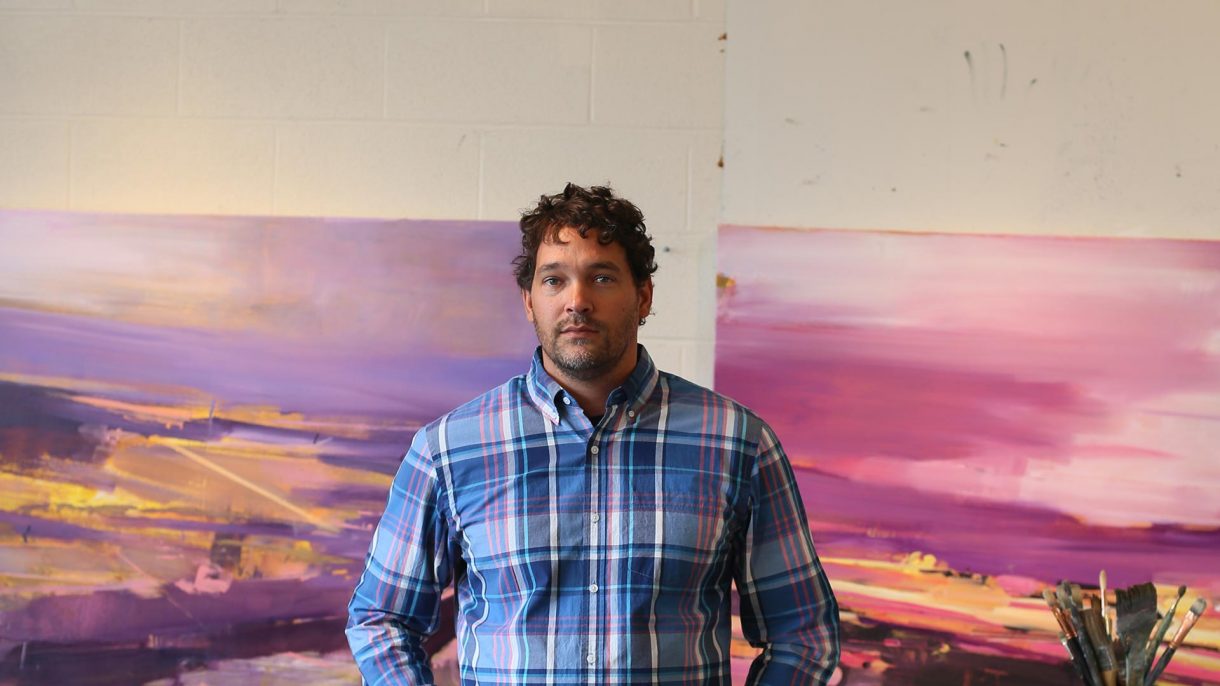
Meet Our Faculty: Chris Segre-Lewis
Originally published in Summer 2015
Asbury University Associate Professor Chris Segre-Lewis’ paintings are like nothing you’ve ever seen. Or maybe they’re like what you’ve seen every day and never noticed.
Known for his vivid, evocative landscapes and hovering, “God-like” perspective, Segre-Lewis doesn’t merely paint pictures of places. His goal is to capture the experience of a place, expanding its 2-D façade “like an accordion.” In his most recent bodies of work, Segre-Lewis explores the intersections of the spiritual and material worlds, the interplay of representation and abstraction and the prophetic witness of a landscape seen through Christian eyes.
“I’ve tried to create this theme that the landscape itself is actually a spiritual sponge, an unseen sign of the spiritual world,” Segre-Lewis said. “It first occurred to me visiting my wife-to-be in Israel. We would drive around visiting these spots I had only read about, and I realized that I wasn’t just looking at places. I was looking at physical manifestations of the Word of God.”
Of all the locations Segre-Lewis visited, none were more moving than Jerusalem. A physical site, formerly the site of a physical temple, Jerusalem still teems with prayers, and for Segre-Lewis, the spiritual reality was palpable.
“When I approached the Wailing Wall, the Spirit of God came upon me, and it was like being hit by a tidal wave,” Segre-Lewis said. “At that point, I realized that for 2,000 years, Jews have invested prayer in this place, and it was like a pitcher that was overflowing.”
Though Jerusalem was a starting point, it’s not the only place Segre-Lewis has experienced a point of contact between the spiritual and material worlds. One of his recent bodies of work, “Tended Earth,” was inspired by the landscape of Yorkshire in Northern England. With its first Christian influence beginning in the fourth century, Segre-Lewis says Yorkshire displays Christian influence in ruins, churches, relics and the landscape itself. The resulting synthesis, viewed from Segre-Lewis’ view, is one of compelling beauty.
“It is a subtle mixture of vernacular architecture and agrarian pragmatism blending to create compositional order,” Segre-Lewis said. “The carefully organized, organic structures respond to the landscape, like a blank canvas responds to human volition and a brush.”
For Segre-Lewis, abstraction is a key element in authentically portraying a landscape. It’s a feature of nature — the silhouette of every tree varies from crooked twig to ragged leaf. Abstraction is the admission that reality transcends cookie-cutter symbology. Segre-Lewis compares this dynamic to the difference between a photograph and a real-life experience. A photograph will convey the bare facts of a landscape in two dimensions, but the full experience of a place involves much more.
“Abstraction comes from nature,” Segre-Lewis said. “This is a funny parable and paradox at the same time. If you want to get at reality, you have to be comfortable with abstraction. If you’re not, you will never get reality. The visual world and the spiritual world is a woven abstraction that comes together, and at some points we can see clarity and then at other points we don’t.”
When it comes to painting, abstraction and representation are dependent, but distinct. For Segre-Lewis, the relationship creates interest while still giving viewers a frame of reference.
“We’re drawn to abstraction because of mystery,” Segre-Lewis said. “It’s the difference between reading ‘Moby Dick’ and Cliff Notes version of ‘Moby Dick.’ The person who wants to be changed will read the book. That’s the thing that frustrates people about my work, as well as what draws people to my work. I give them enough representation to ground themselves, but enough obscurity to raise questions.”
The questions raised vary from viewer to viewer, but some of the most common are questions of faith.
“I want believers and non-believers to experience what it looks like to see the landscape through the eyes of someone in the kingdom of God,” Segre-Lewis said. “A lot of my buyers are not Christians, but the most direct faith questions I get are from people who look at my paintings. They are convinced by the experience.”
Even Segre-Lewis’ distinct vantage point has a role to play in exploring the prophetic role of landscape.
“I generally take a God-like perspective, as if you’re looking at the landscape from above the ground,” Segre-Lewis said. “I try to climb the highest hill or mountain to get the feeling that you’re sitting in the air.
“The perspective from the ground is tight, and all you can see is what’s in front of you, but the higher you get off the ground, the more it looks compositional, and the more you see things from God’s perspective, so to speak.”
Participating in the creative nature of God is personal as much as it is prophetic. Sometimes spending up to six months on a single painting, Segre-Lewis looks at the process of painting as an act of worship.
“It’s not quick,” Segre-Lewis said. “It requires careful matching of color, mark, abstraction and representation, and with every swatch I do, I step into the role of co-creator.
“When I make a mark that looks like a hillside, I feel like I understand more of the creative nature of God — ‘let there be a hill.’ I get this feeling of the pleasure of the Creator, and I want to draw people into that same feeling… help them feel it for themselves.”